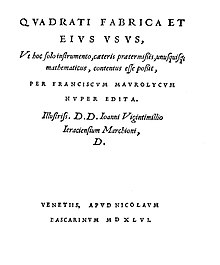弗朗切斯科·马若利科
| 弗朗切斯科·马若利科 | |
|---|---|
 马若利科雕像[1] | |
| 出生 | 1494年9月16日 西西里王国墨西拿 |
| 逝世 | 1575年7月22日 西西里王国墨西拿 |
| 科学生涯 | |
| 研究领域 | 数学,几何学,光学,圆锥曲线,力学,音乐,天文学 |
| 机构 | 墨西拿大学 |
弗朗切斯科·马若利科(英语:Francesco Maurolico,希腊语:Φραγκίσκος Μαυρόλυκος)(1494年9月16日—1575年7月22日)),是西西里王国的数学家和天文学家。他在几何学、光学、圆锥曲线、力学、音乐和天文学领域做出了贡献。他编辑过阿基米德、阿波罗尼奥斯、奥托里库斯、狄奥多西和塞雷诺斯等古典作家的作品。[2]他还撰写了自己独特的数学和数学科学论文。[3]
生活
[编辑]
弗朗切斯科出生于墨西拿,姓Marulì,但有时也有报道说他姓“Mauroli”。[4]他是政府官员安东尼奥·马鲁利(Antonio Marulì)和佩努西亚(Penuccia)的七个儿子之一。他的父亲是一名希腊医生,奥斯曼人入侵君士坦丁堡时,他逃离了君士坦丁堡。[5][6]安东尼奥曾师从新柏拉图派希腊学家君士坦丁·拉斯卡里斯,因此弗朗切斯科通过父亲[7]以及同为拉斯卡利斯弟子的弗朗切斯科·法罗内和贾科莫·热诺维斯接受了 “拉斯卡利斯式 ”教育,其影响是显而易见的。[8][9]
1534年,弗朗切斯科·马鲁利改姓为毛罗·莱科(Mauro Lyco,取自 “神秘的狼 ”之意),此前他作为墨西拿学院的一名成员,曾连续八年使用毛罗·莱西奥(Mauro Lycio,“神秘的阿波罗”)的姓氏。[10]
自 1521 年起,他就已获得牧师圣职,并因此获得了一些教会福利,1550年,杰拉奇锡库洛侯爵西蒙·文蒂米利亚任命为圣玛丽亚德尔帕托修道院(位于卡斯特尔博诺)的修道院长,他是马若利科的学生和赞助人。[11]
1575 年,他在墨西拿自然死亡,当时正值瘟疫流行,数学家因此退隐到墨西拿北部的一个丘陵地带--Contrada Annunziata,Marulì家族在那里拥有一座别墅,该别墅有时可能是这位科学人文主义者所在学院的所在地。[12]
他被安葬在墨西拿的圣乔瓦尼·迪·马耳他教堂,他的侄子弗朗切斯科和西尔维斯特罗·马若利科在那里为他竖立了一个艺术性的大理石石棺,石棺上有叔叔的半身像和马若利科的盾徽,盾徽上有狼和天狼星。
工作
[编辑]1535年,马若利科与画家波利多罗·达·卡拉瓦乔(Polidoro da Caravaggio)合作,为神圣罗马帝国皇帝查理五世进入墨西拿城设计了凯旋门(为这个拱门撰写了拉丁文铭文)。和他的父亲一样,他也成为了墨西拿造币厂的负责人,并一度代表查理五世负责维护城市的防御工事。马若利科是查理在西西里的总督胡安·德·维加的两个儿子的监护人,并得到了许多有钱有势的人的赞助。他还与克里斯托佛·克拉乌和费德里科·科曼迪诺等学者通信。1547年,他与雕塑家乔瓦尼·安杰洛·蒙托索利(Giovanni Angelo Montorsoli)合作,在墨西拿建造了著名的《猎户座喷泉》。[13]1548-1550年间,他作为乔凡尼二世·文蒂米利亚侯爵(Giovanni II Ventimiglia)的客人住在西西里岛的波利纳城堡,并利用城堡的塔楼进行天文观测。
马若利科的天文观测资料中包括1572年仙后座出现的超新星的目击记录。第谷·布拉厄于1574年发表了他的观测细节;这颗超新星现在被称为第谷超新星。
1569 年,他被任命为墨西拿大学教授。
遗产
[编辑]月球上的Maurolycus陨石坑就是以他的名字命名的。
月球环形山马若利科环形山就是以他的名字命名的。
墨西拿有一所以他的名字命名的学校。
2009 年,意大利文化遗产部批准成立 “马若利科数学作品国家版”(Edizione nazionale dell'opera matematica di Francesco Maurolico)。
作品
[编辑]
- 马若利科的《Photismi de lumine et umbra 和 Diaphana》涉及光的折射,并试图解释彩虹这一自然现象。他还研究了暗箱照相机。Photismi于1521年完成,Diaphana第一部分于 1523年完成,第二和第三部分于1552年完成,但所有材料直到1611年才在死后出版。
- 他未发表的手稿《Compaginationes solidorum regularium》(1537 年)包括欧拉公式的陈述 ,早在1752年莱昂哈德·欧拉对凸多面体提出更普遍的证明之前,他就对柏拉图立体提出了这个证明。[14]
- 他的《Arithmeticorum libri duo》(1575 年)包含了第一个已知的数学归纳法证明。[15]
- 他的《De momentis aequalibus》(1548年完成,但1685年才首次出版)试图计算各种物体(金字塔、抛物面等)的质心。
- 在《Sicanicarum rerum compendium》中,他介绍了西西里岛的历史,并包含了一些自传细节。1553年,墨西拿参议院授予他每年100金币的薪水,为期两年,以便他能够完成这部作品和他的数学著作。
- 他的《De Sphaera Liber Unus》(1575年)对哥白尼的日心说进行了猛烈抨击,马若利科在书中写道,哥白尼 “应该受到鞭笞或祸害,而不是驳斥”。[16]
- 马若利科出版了一本《宇宙学》,其中描述了一种测量地球的方法,后来让·皮卡尔(Jean Picard)在1670年测量子午线弧长时采用了这种方法。
- 马若利科出版了亚里士多德的《力学》版本和一部音乐著作。他总结了奥特留斯的《Theatrum orbis terrarum》,还写了《Grammatica rudimenta》(1528年)和《De lineis horariis》。他绘制的西西里岛地图于1575年出版。
- 马若利科研究古代数学典籍: 比提尼亚的狄奥多西、亚历山大的墨涅拉俄斯、皮坦的奥托里库斯、欧几里得、佩尔加的阿波罗尼奥斯和阿基米德。他没有进行新的翻译,而是在现有的基础上,对希腊数学进行了新的、合理的诠释。
出版物
[编辑]- Cosmographia. Venezia: eredi Lucantonio Giunta (1.). 1543 (拉丁语).
- Cosmographia. Paris: Guillaume Cavellat. 1558 (拉丁语).
- Photismi de lumine et umbra ad perspectivam et radiorum incidentiam facientes. Napolo: Tarquinio Longo. 1611 (拉丁语).
相关
[编辑]- 暗箱
- 重心
- Commandino定理
- 笛卡尔论多面体
- 罗马天主教科学家兼神职人员列表
- 文艺复兴时期的希腊学者
- 数学归纳法
- 八面体数
- 微积分和数学分析的时间线
参考
[编辑]- ^ Renate Burgess/Wellcome Institute of the History of Medicine, Portraits of doctors & scientists in the Wellcome Institute of the History of Medicine: a catalogue, Wellcome Institute of the History of Medicine, 1973 (Wellcome Institute for the History of Medicine), page 239
- ^ Galluzzi, Paolo. Novità celesti e crisi del sapere. Banca toscana. 1984: 132. OCLC 59935636.
Francesco Maurolico (1494-1575) Maurolico was a Sicilian, descended from Greek immigrants. He had an active career as civil servant, abbot, historian, and teacher. His passion was for mathematics, and his aim was to restore European knowledge of the ancient Greek mathematical achievement To the latter end, he vigorously pursued his own mathematical studies; edited the works of Archimedes, Apollonius, Autolycus, Theodosius, and Serenus; summarized and commented on Euclid's Elements; paraphrased and edited various medieval mathematical works or medieval translations of ancient works; and composed his own original treatises on mathematics and mathematical science.
- ^ Galluzzi, Paolo. Novità celesti e crisi del sapere. Banca toscana. 1984: 132. OCLC 59935636.
Francesco Maurolico (1494-1575) Maurolico was a Sicilian, descended from Greek immigrants. He had an active career as civil servant, abbot, historian, and teacher. His passion was for mathematics, and his aim was to restore European knowledge of the ancient Greek mathematical achievement To the latter end, he vigorously pursued his own mathematical studies; edited the works of Archimedes, Apollonius, Autolycus, Theodosius, and Serenus; summarized and commented on Euclid's Elements; paraphrased and edited various medieval mathematical works or medieval translations of ancient works; and composed his own original treatises on mathematics and mathematical science.
- ^ "MAUROLICO, Francesco" by Rosario Moscheo, Dizionario Biografico degli Italiani, Volume 72 (2008).
- ^ J J O'Connor and E F Robertson. Francesco Maurolico. School of Mathematics and Statistics University of St Andrews, Scotland. November 1, 2010 [May 4, 2021].
- ^ Richard S. Westfall. Maurolico [Marul, Marol], Francesco. The Galileo Project Department of History and Philosophy of Science Indiana University. January 1, 1995 [May 4, 2021].
- ^ "MAUROLICO, Francesco" by Rosario Moscheo, Dizionario Biografico degli Italiani, Volume 72 (2008).
- ^ Russo, Attilio (2018). "Una nuova ipotesi sul nome 'Maurolico' ", Archivio Storico Messinese, 99, Messina 2018, 37-71, especially 50-51 and 70-71 note 69. ISSN 1122-701X
- ^ "MAUROLICO, Francesco" by Rosario Moscheo, Dizionario Biografico degli Italiani, Volume 72 (2008).
- ^ Russo, Attilio (2018). "Una nuova ipotesi sul nome 'Maurolico' ", Archivio Storico Messinese, 99, Messina 2018, 37-71. ISSN 1122-701X
- ^ "MAUROLICO, Francesco" by Rosario Moscheo, Dizionario Biografico degli Italiani, Volume 72 (2008).
- ^ Russo, Attilio (2018). "Una nuova ipotesi sul nome 'Maurolico' ", Archivio Storico Messinese, 99, Messina 2018, 37-71, especially 58-64. ISSN 1122-701X
- ^ Russo, Attilio (2001). "La fontana del Sirio d'Orione, o delle metamorfosi", Città & Territorio, II/2001, Messina 2001, pp. 30-41.
- ^ Friedman, Michael. A History of Folding in Mathematics: Mathematizing the Margins. Science Networks. Historical Studies 59. Birkhäuser. 2018: 71. ISBN 978-3-319-72486-7. doi:10.1007/978-3-319-72487-4.
- ^ Vacca, Giovanni. Maurolycus, the first discoverer of the principle of mathematical induction (PDF). Bull. Amer. Math. Soc. 1909, 16 (2): 70–73. MR 1558845. doi:10.1090/s0002-9904-1909-01860-9
 .
.
- ^ Rosen, Edward. Maurolico's attitude toward Copernicus. Proceedings of the American Philosophical Society. 1957, 101 (2): 177–194.

